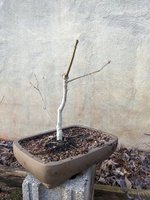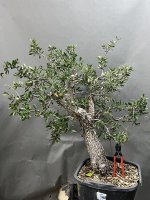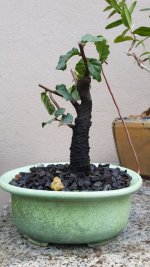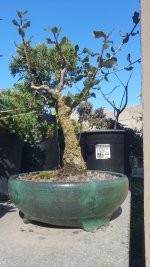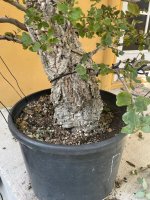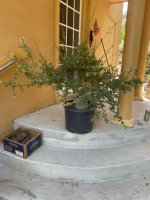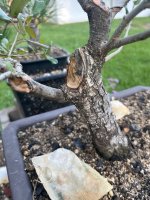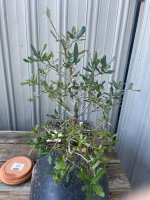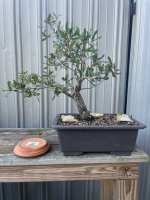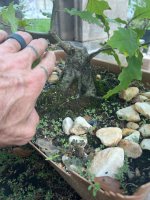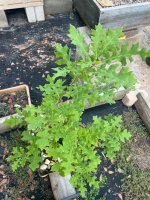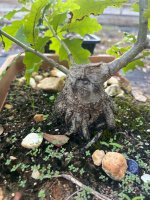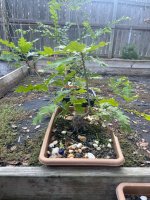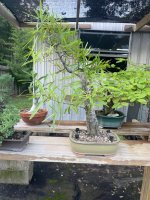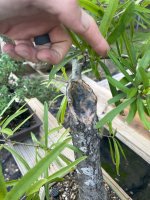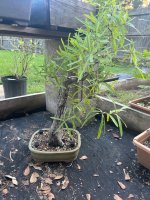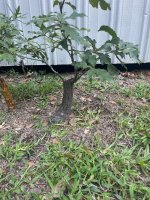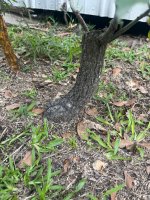I agree that the probable identity of your tree imaged is Quercus laurifolia.
I have a tendency to focus on details. Not always important details. One of my "bug-a-boos" is plant names and taxonomy. Getting names "right" is a thing I focus in on, but in bonsai is not all that important. In judging orchids, it is critical that species are identified correctly and hybrids have accurate parentages listed. I have in the past exhibited orchids, and made "the deep dive" into orchid taxonomy for a while. Then I got a life. (LOL) In bonsai the image created is most important and accuracy of botanical names is a secondary or minor issue. So with this thought in mind I offer the following with the suggestion that where possible, include the botanical name of the species you are referring to when you use common names. Citing the botanical name only needs to be done once in a discussion, if there is no ambiguity, I know I sound pompous if I repeatedly use botanical names when everyone else in the thread is using common names.
Laurel Oak - 2 different species share Laurel Oak as a common name, Quercus laurifolia and Quercus hemisphaerica also known as Darlington oak
Quercus laurifolia "Laural oak" is in the same botanical section (Lobata) as red oak, Quercus rubra. Common names for Laurel Oak include swamp laurel oak, diamond leaf oak, water oak, and obtusa oak, Laurel oak, swamp laurel oak, and diamond leaf oak are probably the most used common names. This oak tends to grow on flood plains, areas that experience seasonal flooding or occasional flooding. If found in upland sites they tend to be in areas with poor drainage. They flower late winter or early spring, before or as new leaves begin to emerge. Quercus laurifolia is tardily deciduous, with foliage dropping over the course of the winter. Foliage is replaced every year. Leaves are rhombic in shape and taper to the leaf petiole, stem that attaches to the branch. Leaves are wider than Q. hemisphaerica, and are occasionally 3 lobed. It is hardy as far north as Cincinnati, Ohio, as there are specimens there that have survived more than 50 years. The article in Wikipedia did not note whether the Cincinnati trees were planted as ornamentals or represent northern outliers of their natural distribution. My guess is they were planted as ornamentals.
Quercus hemisphaerica - Darlington oak, also called Laurel oak, sand laurel oak, and laurel leaf oak - this species is also in the same botanical section (Lobata) as red oak, Quercus rubra. Quercus hemisphaerica tends to grow in more upland sites in sand. Much drier sites than Q. laurifolia, Q. hemisphaerica tends to flower about two weeks later than Q. laurifolia. Leaves are narrow ovate, more narrow than Q. laurifolia. Leaves are occasionally coarsely toothed, though most leaves have smooth margins. They are not usually lobed. Leaves tend to be evergreen.
Water Oak - Quercus nigra - has many common names including spotted oak, duck oak, punk oak, orange oak and possum oak. Oddly, the botanical name Q. nigra, "nigra" means black, yet black oak is not listed as a common name for Quercus nigra. The common name "black oak" most often refers to Quercus velutina. Leaves are spatula shaped with a broad distal end tapering, wedge shaped to the leaf petiole. It is tardily deciduous. Preferred habitat is similar to that for weeping willows, streambanks and edges of ponds, sometimes swampy waterlogged soils, or areas prone to flooding. It will tolerate compacted soils, and has been found growing in red clay soils. It is not normally planted as an ornamental. Its wood resembles red oak, Q. rubra, and is often sold as red oak lumber. Water oak, Q. nigra is in the Lobata section of genus Quercus meaning it is in the red oak section.
Chapman Oak - Quercus chapmanii in same botanical section as Quercus alba, the white oaks. Its natural range is more restricted than the above species, it occurs mainly in Florida with some outliers in adjacent states. Wikipedia does not say much about this species and photos of leaves are not close up enough to help with identification.
So this sums up most of what Wikipedia has to offer about Laurel and Water Oaks.
I find Wikipedia is very useful tool for botanical questions, if you already know "a little" about the plant in question. It is terrible as a "primary identification guide" because information is not of equal depth between species.






